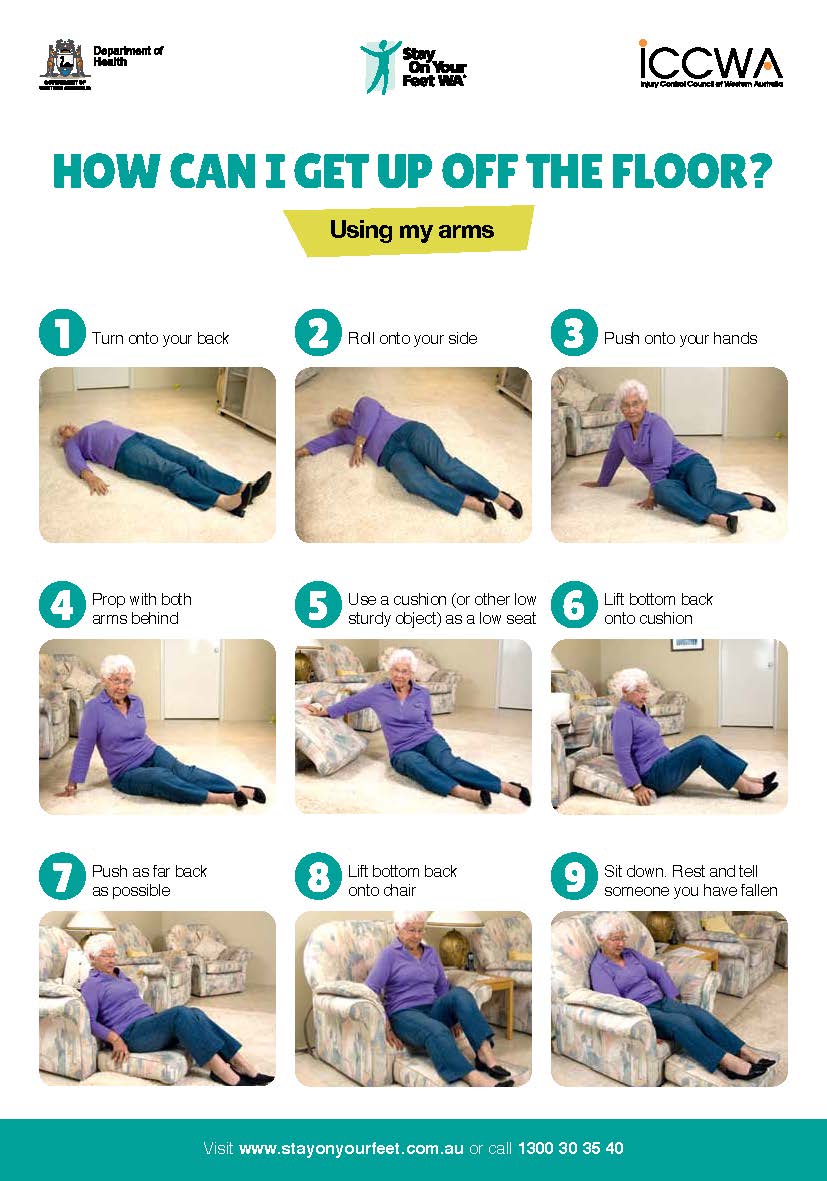Have you ever seen someone struggling to get up from the floor and felt that pang of empathy, wondering if you should offer a hand? It’s a simple act, but it can make a world of difference to someone who might be feeling vulnerable or embarrassed. Whether it’s an elderly neighbor, a child who’s taken a tumble, or someone who’s simply lost their balance, knowing how to help someone up safely and compassionately is an essential life skill.

Image: www.parkinsonsnsw.org.au
Helping someone up from the floor isn’t just about offering physical assistance; it’s about extending a hand of kindness and understanding. This guide will arm you with the knowledge and confidence to provide support in a way that’s both helpful and respectful, ensuring their safety and fostering a sense of reassurance.
Approaching the Situation with Care
The first step is approaching the situation with empathy and caution. It’s essential to be mindful of the person’s feelings and respect their autonomy. Assess the situation carefully, and remember that everyone’s circumstances are different.
-
Ask for Consent: Before you lend a hand, always ask for permission. A simple, “Would you like some help getting up?” goes a long way in demonstrating respect. Remember, some people might prefer to manage on their own, and their choice should be honored.
-
Consider Their Needs: Take a moment to evaluate the person’s condition. Are they hurt? Are they feeling dizzy or weak? If you suspect an injury, call for medical assistance. If they seem unsteady, offer your support but avoid rushing them.
-
Provide Emotional Support: Even if someone doesn’t need physical assistance, offering words of encouragement and reassurance can go a long way. A simple, “Are you okay?” or “I’m here to help if you need anything” can help alleviate anxiety and provide comfort.
Techniques for Safe Assistance
Once you have their consent, you can begin offering support with these safe and effective techniques:
-
The Two-Hand Method: This is a classic approach that provides excellent stability for both you and the person being helped. Stand on one side of the person, facing them. Place one hand under their armpit, with your palm facing their back. Place your other hand on their opposite hip.
-
The One-Hand Method: This method is useful if you have limited space or if the person only requires minimal assistance. Stand on one side of the person. Place your hand under their armpit, with your palm facing their back, and hold their arm close to their body.
-
The Gentle Lift: If the person is unable to support their own weight, use the two-hand method to gently lift them. Bend your knees and keep your back straight as you lift.
-
Using a Chair or Other Support: If possible, place a stable chair or other object in front of the person so they can grasp it for support. This can make it easier for them to pull themselves up.
Handling Specific Situations
-
Helping a Child: When helping a child, it’s essential to use gentle and supportive language. Explain what you’re going to do and reassure them. Use a kneeling position so you are closer to their height and can offer a firm but encouraging grip.
-
Assisting an Elderly Person: When helping an elderly person, approach with patience and understanding. They may need additional time and assistance. Ask them if they have any specific needs or preferences.
-
Helping Someone with a Disability: Treat individuals with disabilities with respect and dignity. Ask them about their specific needs and preferences, and be prepared to offer assistance in a way that is most comfortable for them.

Image: ar.inspiredpencil.com
Safety Precautions: Remembering Your Well-being
While it’s commendable to offer assistance, remember to prioritize your own safety. Avoid putting yourself in a position where you could be injured.
-
Maintain Stability: Keep your feet firmly planted, with your knees slightly bent. This provides a solid base and reduces the risk of losing your balance.
-
Use Proper Body Mechanics: Avoid straining your back by lifting with your legs, not your back. If you are lifting, keep your spine straight.
-
Listen to Your Body: If you feel any pain or discomfort, stop and ask for another person to assist. It’s better to be cautious than to risk injury.
Preventing Falls: A Proactive Approach
While assisting someone who has already fallen is important, preventing falls in the first place is even better. Here are a few steps you can take to make your environment safer.
-
Clear Clutter: Objects like cords, furniture, and toys can create tripping hazards. Ensure pathways are clear and well-lit.
-
Secure Rugs and Carpets: Use non-slip backing or tape to secure rugs, and consider removing loose carpets.
-
Install Handrails: Install handrails on stairs, in bathrooms, and in any areas where there is a higher risk of falling.
-
Enhance Lighting: Make sure your home is well-lit, especially in areas where people might be walking in the dark.
Building a Culture of Kindness and Support
Helping someone up from the floor is about more than just physical assistance; it’s about fostering a culture of kindness, compassion, and empathy. By being a good neighbor and offering a helping hand, we can make our communities a more supportive and caring place for everyone.
How To Help Someone Up From The Floor
Conclusion
From asking for consent to using proper techniques and prioritizing safety, helping someone up from the floor requires a mix of compassion, awareness, and practical skills. By following these guidelines, you can make a positive difference in someone’s life. Whether it’s a small act of kindness or a life-changing moment, extending a hand can create a ripple effect of support that reverberates throughout our communities. So the next time you see someone in need, remember that your willingness to help can make a world of difference.

:max_bytes(150000):strip_icc()/OrangeGloEverydayHardwoodFloorCleaner22oz-5a95a4dd04d1cf0037cbd59c.jpeg?w=740&resize=740,414&ssl=1)




